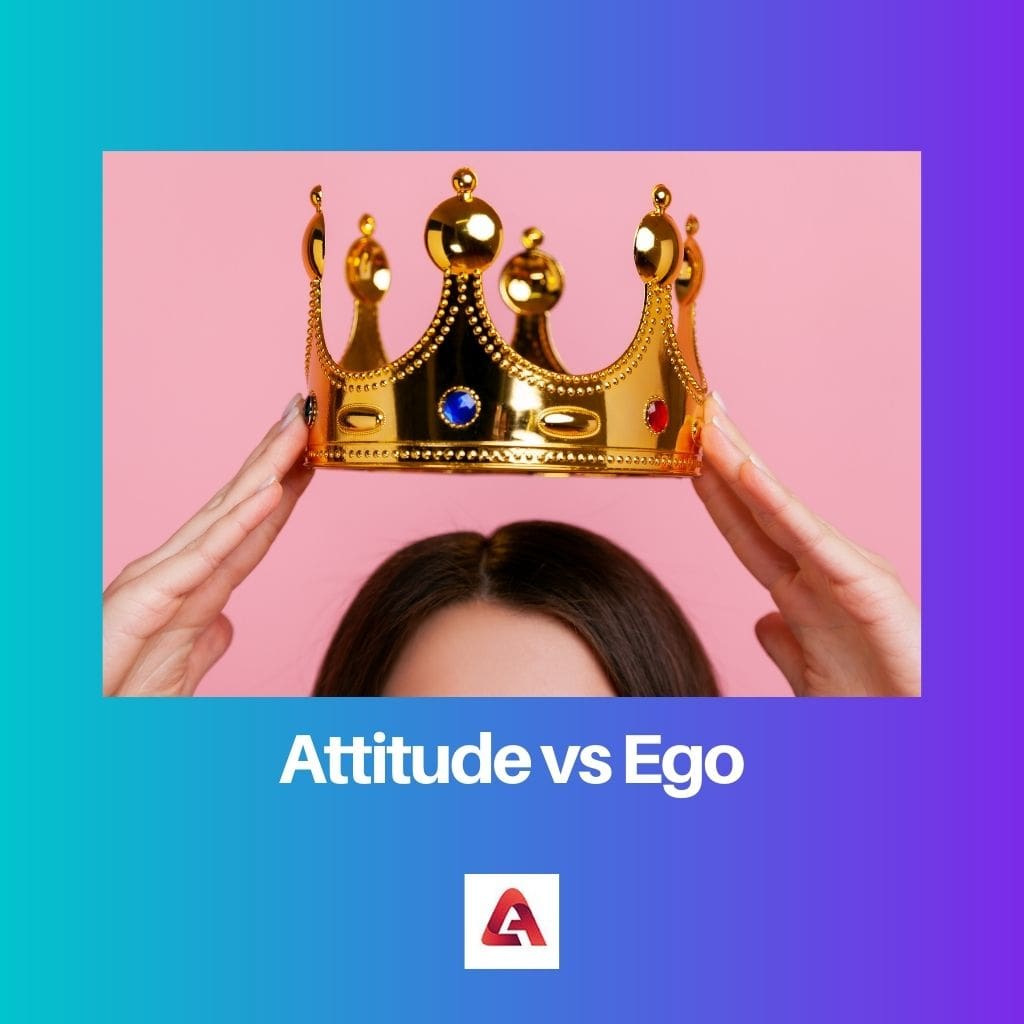Attitude reflects one’s perspective and behavior towards situations and others, shaped by beliefs and experiences. Ego, on the other hand, is an inflated sense of self-importance that often hinders genuine connection and growth, driven by insecurity and fear of vulnerability. While attitude can foster positive interactions and adaptability, ego can lead to rigidity and conflict, ultimately impacting personal and professional relationships.
Key Takeaways
- Attitude refers to a person’s mental disposition or feelings toward a particular subject or situation, reflected in behavior or body language; ego is a person’s sense of self-esteem, self-importance, or self-identity.
- Attitude can be positive or negative and is influenced by a person’s beliefs, values, and experiences; ego is related to self-perception and can affect how a person interacts with others and responds to feedback.
- Both attitude and ego impact a person’s behavior and relationships, but attitude is focused on feelings and opinions, while ego centers on self-awareness and self-worth.
Attitude vs Ego
Attitude refers to the way a person thinks, feels, and behaves towards a particular situation or object, and is a combination of beliefs, values, and emotions that shape an individual’s actions with the world around them. Ego refers to an individual’s sense of self-importance and self-worth.

Comparison Table
| Feature | Attitude | Ego |
|---|---|---|
| Definition | A mental state or disposition that influences thoughts, feelings, and behavior towards a specific person, object, or situation. | A person’s sense of self-importance or self-esteem. |
| Focus | External: Concerned with how individuals perceive and respond to the world around them. | Internal: Focused on one’s own perceived abilities, achievements, and importance. |
| Flexibility | Can be modified and changed based on new information, experiences, or perspectives. | Tends to be more fixed and resistant to change, especially when threatened. |
| Impact on Behavior | Can influence how individuals interact with others and make decisions. | Can motivate or hinder achievement, and influence interpersonal relationships. |
| Examples | Positive attitude towards learning, negative attitude towards conflict. | Inflated ego leading to arrogance, fragile ego leading to defensiveness. |
What is Attitude?
Components of Attitude:
- Cognitive Component: This component involves the beliefs and thoughts a person holds about a particular object, person, or situation. These beliefs are based on past experiences, knowledge, and information processing. For example, someone may have a positive cognitive attitude towards exercising based on the belief that it improves health and well-being.
- Affective Component: The affective component of attitude encompasses the emotional reactions and feelings associated with the object of attitude. These emotions can range from positive (e.g., love, joy) to negative (e.g., fear, disgust) and influence how individuals feel about and respond to the object. For instance, an individual may feel anxious about public speaking due to a negative affective attitude towards it.
- Behavioral Component: This component involves the behavioral tendencies and actions that result from one’s attitude towards a particular object, person, or situation. It reflects how individuals express their attitudes through their actions, such as avoidance or approach behaviors. For example, someone with a positive attitude towards volunteering may actively seek out opportunities to contribute to their community.
Formation of Attitudes:
Attitudes can develop through various processes, including:
- Socialization: Attitudes often form through social interactions and experiences within family, peer groups, and society at large. Individuals may adopt attitudes from significant others or influential figures in their lives.
- Direct Experience: Personal experiences and interactions with the object of attitude can shape one’s beliefs, emotions, and behaviors towards it. Positive experiences may reinforce positive attitudes, while negative experiences can lead to attitude change or adjustment.
- Cognitive Dissonance: When there is a discrepancy between attitudes and behaviors, individuals may experience cognitive dissonance, a discomfort that motivates them to align their attitudes and actions. This process can lead to attitude change or rationalization of behavior.
Impact of Attitude:
Attitudes play a crucial role in shaping human behavior and interactions in various domains, including:
- Interpersonal Relationships: Attitudes influence how individuals perceive and interact with others, impacting the quality of relationships. Positive attitudes foster empathy, cooperation, and understanding, while negative attitudes can lead to conflict and alienation.
- Workplace Dynamics: Attitudes towards work, colleagues, and organizational culture influence job satisfaction, productivity, and organizational commitment. Positive attitudes contribute to a positive work environment and employee engagement, while negative attitudes can lead to absenteeism, turnover, and reduced performance.
- Consumer Behavior: Attitudes towards products, brands, and marketing messages influence consumer decisions and purchasing behavior. Marketers often seek to understand and influence consumer attitudes through advertising, branding, and product positioning strategies.

What is Ego?
Origins and Development:
- Freudian Perspective: Sigmund Freud introduced the concept of the ego as one of the three components of personality, alongside the id and superego, in his psychoanalytic theory. He described the ego as the rational, reality-oriented part of the psyche that emerges during infancy to navigate the demands of the external world.
- Formation: The ego develops through interactions with caregivers and the environment, learning to manage instincts, impulses, and external demands. It evolves as a result of experiences, socialization, and the internalization of societal norms and values.
Characteristics and Functions:
- Reality Principle: The ego operates according to the reality principle, seeking to satisfy the id’s demands in a manner acceptable to the external world. It balances instinctual drives with the constraints of reality, considering consequences and employing defense mechanisms to manage conflicts.
- Executive Functioning: The ego serves as the executive branch of personality, making decisions, mediating between internal desires and external demands, and regulating behavior. It employs rational thinking, problem-solving skills, and adaptive strategies to navigate life’s challenges.
- Identity and Self-Image: The ego constructs a sense of identity and self-image, integrating internal experiences and external feedback to form a cohesive sense of self. It shapes how individuals perceive themselves and others, influencing self-esteem, self-efficacy, and interpersonal relationships.
Ego in Everyday Life:
- Defense Mechanisms: The ego employs defense mechanisms, such as denial, repression, and rationalization, to protect the individual from anxiety-provoking thoughts and conflicts. These mechanisms serve to maintain psychological equilibrium but can also lead to maladaptive patterns of coping.
- Self-Presentation: Ego plays a crucial role in self-presentation, shaping how individuals present themselves to others and manage their social image. It influences behavior in social situations, driving motives such as the need for approval, recognition, and validation.
- Impact on Behavior: The ego influences a wide range of behaviors, including decision-making, goal pursuit, and interpersonal interactions. It mediates between competing desires and societal norms, often leading to compromises, adaptations, or conflicts.
Challenges and Growth:
- Ego Strength: Individuals vary in ego strength, ranging from resilience and adaptability to vulnerability and fragility. Developing a strong and flexible ego involves self-awareness, emotional regulation, and the ability to tolerate uncertainty and ambiguity.
- Ego Inflation and Deflation: Excessive ego inflation can lead to narcissism, arrogance, and entitlement, impairing relationships and hindering personal growth. Conversely, ego deflation can result from setbacks, failures, or criticism, leading to feelings of inadequacy and low self-worth.
- Ego Development: Throughout life, individuals continue to undergo ego development, influenced by experiences, relationships, and existential challenges. Cultivating humility, empathy, and authenticity can foster ego maturity and psychological well-being.

Main Differences Between Attitude and Ego
- Nature:
- Attitude: Reflects one’s perspective and behavioral tendencies towards objects, individuals, or situations, shaped by beliefs and experiences.
- Ego: Represents the conscious sense of self, mediating between internal desires and external realities, influenced by socialization and developmental processes.
- Components:
- Attitude: Comprises cognitive (beliefs), affective (emotions), and behavioral (actions) components that influence how individuals perceive and respond to the world.
- Ego: Functions as a cohesive identity and executive function of personality, regulating behavior, decision-making, and self-presentation.
- Role in Relationships:
- Attitude: Affects interpersonal dynamics, shaping the quality of relationships based on positive or negative attitudes towards others.
- Ego: Influences self-perception and social interactions, balancing individual desires with societal expectations, and managing defense mechanisms to protect against anxiety and conflicts.
- Development and Growth:
- Attitude: Can evolve through socialization, direct experiences, and cognitive processes, impacting behavior and decision-making.
- Ego: Develops over time through interactions with caregivers and the environment, with opportunities for ego strength development or challenges such as ego inflation or deflation.
- Impact on Behavior:
- Attitude: Guides actions and decisions based on beliefs, emotions, and behavioral tendencies towards specific objects or situations.
- Ego: Regulates behavior by balancing instinctual drives with reality constraints, employing defense mechanisms, and managing social interactions and self-presentation.

- https://europepmc.org/abstract/med/254899
- https://www.pep-web.org/document.php?id=IRP.004.0409A
- https://www.emerald.com/insight/content/doi/10.1108/JIMA-11-2014-0074/full/html

The article did a great job of breaking down the concept of ego and its influence on a person’s psyche. It was a compelling read!
I’m glad you found it compelling, Nick. The discussion on the social, economic, and occupational factors that shape ego was quite enlightening.
Very insightful article! I learned a lot about the differences between attitude and ego. It’s fascinating how they both play a role in shaping our behavior and perceptions.
I completely agree with you, James. This article really delves deep into the complexities of attitude and ego.
I have a different perspective on this. I think the article oversimplified the complexities of attitude and ego, and didn’t address their interconnected nature.
I found this article to be quite informative and comprehensive. The comparison table provided a clear understanding of the distinctions between attitude and ego.
Absolutely, Dave. The examples given really helped solidify the differences between the two concepts.
This article presented a well-researched exploration of attitude and ego. The section on implicit and explicit attitudes was particularly thought-provoking.
I share the same sentiment, Hollie. The insights provided in this article were truly eye-opening.
The section on the cognitive, affective, and behavioral components of attitudes was enlightening. Kudos to the author for shedding light on this intricacy.
The discussion on the formation of attitudes and the role of various factors in shaping them was enlightening. An informative and thoroughly researched piece.
I couldn’t agree more, Ross. The article provided valuable insights into the intricate mechanisms of attitude and ego formation.
The comparison table was quite helpful in understanding the distinctions between attitude and ego. Comical inclusions of example phrases added a touch of humor to the article!
The humor was a nice touch, but I believe the article could have delved deeper into the societal implications of attitude and ego.
I agree, Riley. The article managed to make a complex topic engaging and lighthearted. An enjoyable read indeed.
This article was quite thought-provoking, and I appreciated the in-depth analysis of the factors that contribute to the formation of attitudes.
I couldn’t agree more, Fiona. The section on the cognitive, affective, and behavioral components of attitudes was particularly insightful.
I found the article to be lacking in its exploration of the interconnectedness between attitude and ego. Further examination of this aspect would have been beneficial.